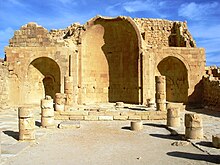| Revision as of 11:26, 8 July 2010 edit85.65.99.40 (talk) + section on housing after 1948← Previous edit | Revision as of 11:27, 8 July 2010 edit undo85.65.99.40 (talk)No edit summaryNext edit → | ||
| Line 30: | Line 30: | ||
| ===After Israeli independence=== | ===After Israeli independence=== | ||
| From 1948, architecture in Israel was dominated by the need to house masses of new immigrants. The ] concrete style suited Isarel's harsh climate and paucity of natural building materials. | From 1948, architecture in Israel was dominated by the need to house masses of new immigrants. The ] concrete style suited Isarel's harsh climate and paucity of natural building materials. | ||
| <ref></ref> | <ref></ref> | ||
Revision as of 11:27, 8 July 2010
The architecture of Israel is composed of many different styles of building brought in by those who have occupied the country over the ages, sometimes modified to suit the local climate and landscape. Fortified Crusader castles, Islamic madrassas, Byzantine churches, Templer houses, Bauhaus-style modernist buildings, Arab arches and minarets, Russian Orthodox onion domes, and soaring glass-sided skyscrapers - all are part of the architecture of Israel.

Architectural styles

The Arabs built small stone houses on the hillsides with flat or dome roofs. The Crusaders built fortresses on strategic hilltops. The Christians built churches to mark sites where Jesus walked. The Templers built homes with tiled roofs like those in the German countryside. The British Mandatory authorities passed a law requiring all construction in Jerusalem to be of Jerusalem stone and introduced the idea of garden suburbs. In the early years of statehood, Israel built rows of concrete tenements to accommodate the masses of new immigrants to replace the huts, tents and packing crates of the maabarot. Tel Aviv's White City of Tel Aviv has been declared a UNESCO World Heritage Site. As property values have risen, skyscrapers are going up around the country. The Moshe Aviv Tower in Ramat Gan is the tallest building in Israel to date.
Leading architects
Dov Karmi, Zeev Rechter and Arieh Sharon were among the leading architects of the early 1950s. Rudolf (Reuven) Trostler played an important role in designing the country's early industrial buildings. Dora Gad designed the interiors of the Knesset, the Israel Museum, the country's first large hotels, the Jewish National and University Library, El Al planes and Zim passenger ships.
Historical developments
Traditional rural house
Until the end of the 19th century, the traditional rural house in the villages of Israel consisted of a single room without partitions, divided into levels in accordance with various functions carried out in the house:
- Rawiyeh – a bottom level at the elevation of the courtyard considered the “dirty” part of the house, used for storage and sheltering livestock.
- Mastabeh – A higher residential level used for sleeping, eating, hospitality and storage.
- Sida (gallery) – Another living area above the mastaba, used primarily for sleeping.
In the second half of the 19th century, a residential story characterized by a cross-vault was added above the traditional house, creating a created between the floor with the livestock in the bottom room and the residential story. A separate entrance was installed in each story.
Fortified house
These houses were built outside the village core and had two stories: a raised ground floor with tiny windows used for raising livestock and storage, and a separate residential floor with large windows and balconies. In the courtyard was a small structure used for storage. Sometimes a tabun baking oven would be located inside it.
Farmhouses
The first modern building technology was evident in the farmhouses. Iron beams were used and the roofs were made of concrete and roof tiles. These structures had balconies with a view and wide doorways.
Modern housing (British Mandate)
Modern housing built during the British Mandate was urban in character, with flat roofs, rectangular doorways and painted floor tiles.
After Israeli independence
From 1948, architecture in Israel was dominated by the need to house masses of new immigrants. The Brutalist concrete style suited Isarel's harsh climate and paucity of natural building materials.
References
- Encyclopedia of Zionism and Israel, edited by Raphael Patai, Herzl Press, McGraw, New York, 1971 "Architecture and Town Planning in Israel," Vol. 1, pp. 71-76
- ^ A Concrete Life, Noam Dvir, Haaretz Magazine, October 17, 2008
- Dora Gad's private sanctuary
- Heritage Conservation in Israel
- Heritage Conservation in Israel
- Heritage Conservation in Israel
- Heritage Conservation in Israel
- Heritage Conservation in Israel
- Sir Banister Fletcher's A History of Architecture
External links
- A little modesty goes a long way David Kroyanker
- Fifty years of Israeli architecture David Kroyanker
- Jerusalem: Architecture in the late Ottoman Period Lili Eylon
- Historical Architecture and Design in Israel